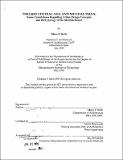| dc.contributor.advisor | Attilio Petruccioli. | en_US |
| dc.contributor.author | Sobti, Manu P | en_US |
| dc.coverage.spatial | a-ii--- | en_US |
| dc.date.accessioned | 2010-04-28T15:28:56Z | |
| dc.date.available | 2010-04-28T15:28:56Z | |
| dc.date.copyright | 1995 | en_US |
| dc.date.issued | 1995 | en_US |
| dc.identifier.uri | http://hdl.handle.net/1721.1/54413 | |
| dc.description | Thesis (M.S.)--Massachusetts Institute of Technology, Dept. of Architecture, 1995. | en_US |
| dc.description | Includes bibliographical references (p. 141-145). | en_US |
| dc.description.abstract | This thesis commences with the basic premise that Timurid Central Asia (which included the regions of Khorasan and Transoxania), with its monumental achievements in Urban Planning and Civic Architecture, beginning with the reign of Tamerlane (1346 - 1405); served as a literal source of inspiration for the urban form of Mughal cities. As an additional corollary to this premise, it puts forward the thesis that the formal similarities observed between the architecture of the Timurids and the Mughals were not purely coincidental; but were indeed the result of a conscious exchange of ideas and images in a varied number of ways. The Mughals seem to have essentially emulated the Timurids in terms of the basic grammar of their architectural creations, and the final product was always unique in terms of the extent, purity and the mix of constituent elements. This cross-cultural 'borrowing' seems to have become more direct and relatively refined when one considers developments in the realm of city planning; where to a large extent, there seems to have operated a 'stereo-typical' notion or model of the urban settlement - predominantly Timurid or deriving from Timurid precedents; which is thereafter applied and overlaid with 'Indianized' or 'Persianized' notions in order to develop the characteristics of the Mughal city. The first part of the thesis examines how pre-Timurid precedents could have contributed towards the conception of a Timurid Urban Model. The characteristics this model and its variations are subsequently discussed with reference to specific cases. The second part discusses correlations between the Timurid and Mughal city in terms of a matrix of political and social variables derived from conditions prevalent in Timurid and Mughal society. The third part of the research looks at factors or agents which may have caused the this cultural interchange to occour between the two cultures. | en_US |
| dc.description.statementofresponsibility | by Manu P. Sobti. | en_US |
| dc.format.extent | 147 p. | en_US |
| dc.language.iso | eng | en_US |
| dc.publisher | Massachusetts Institute of Technology | en_US |
| dc.rights | M.I.T. theses are protected by
copyright. They may be viewed from this source for any purpose, but
reproduction or distribution in any format is prohibited without written
permission. See provided URL for inquiries about permission. | en_US |
| dc.rights.uri | http://dspace.mit.edu/handle/1721.1/7582 | en_US |
| dc.subject | Architecture | en_US |
| dc.title | Timurid central Asia and Mughal India : some correlations regarding urban design concepts and the typology of the Muslim house | en_US |
| dc.type | Thesis | en_US |
| dc.description.degree | M.S. | en_US |
| dc.contributor.department | Massachusetts Institute of Technology. Department of Architecture | |
| dc.identifier.oclc | 33337527 | en_US |
